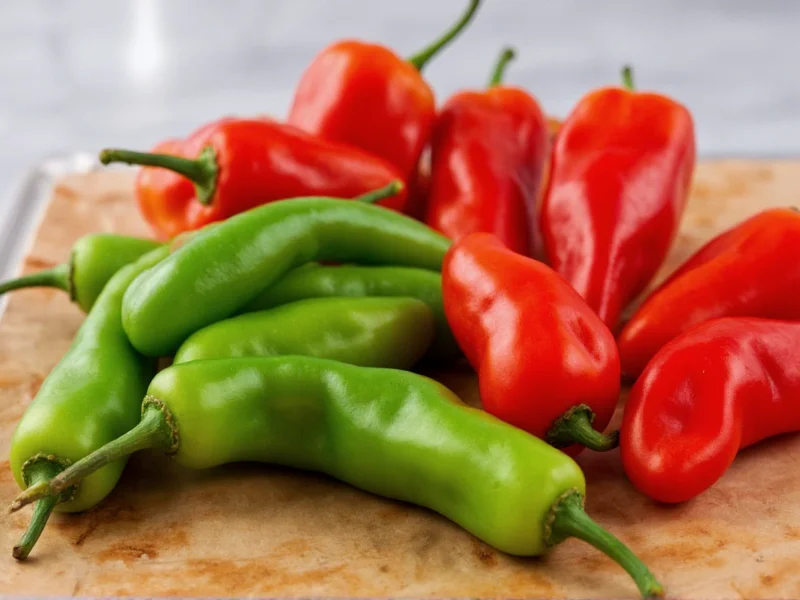Knowing precisely when to pick serrano peppers makes the difference between mediocre and exceptional harvests. These fiery chilies, ranking 10,000-23,000 on the Scoville scale, develop their signature heat and flavor profile based on harvest timing. Whether you're growing them in your backyard garden or greenhouse, understanding the maturation process ensures you capture their peak culinary potential.
Understanding Serrano Pepper Maturation Stages
Serrano peppers progress through distinct developmental phases that directly impact their flavor, heat level, and culinary applications. Unlike some chili varieties that must fully ripen to change color, serranos deliver excellent flavor at multiple stages.
| Maturation Stage | Appearance | Days After Flowering | Flavor Profile | Best Culinary Uses |
|---|---|---|---|---|
| Immature (Early Harvest) | Pale green, thin-walled | 50-60 days | Mild heat, grassy flavor | Raw in salads, quick pickling |
| Optimal Green Stage | Bright green, firm, 2-4" long | 70-80 days | Full heat development, crisp texture | Salsas, hot sauces, roasting |
| Color Transition Stage | Green with red/orange streaks | 85-95 days | Complex flavor, maximum heat | Drying, specialty sauces |
| Full Color Ripeness | Completely red, orange, or yellow | 100+ days | Sweeter, fruitier notes | Preserves, gourmet dishes |
Key Indicators That Serrano Peppers Are Ready to Pick
Successful harvesting depends on recognizing multiple physical characteristics rather than relying solely on calendar days. Environmental factors like temperature, sunlight, and soil conditions significantly influence maturation speed.
Visual Cues for Harvest Readiness
The most reliable visual indicator is consistent bright green color throughout the pepper. Avoid harvesting when peppers show pale or yellowish patches, which indicate immaturity. As serranos approach peak ripeness, they develop a glossy sheen rather than a dull appearance. When allowed to continue ripening, they'll gradually transition through yellow to vibrant red—this color change happens from the stem downward.
Tactile Assessment Techniques
Gently squeeze the pepper to assess firmness. Mature serranos feel solid and dense, not soft or spongy. The skin should feel tight against the flesh with no wrinkles. A simple 'lift test' works well: mature peppers detach easily with a slight upward motion, while immature ones resist separation from the plant. Never force separation, as this can damage the plant's fruiting nodes.
How Harvest Timing Affects Heat and Flavor
The timing of your serrano pepper harvest dramatically influences both heat intensity and flavor complexity. Understanding this relationship helps match your harvest to specific culinary applications.
Peppers harvested at the bright green stage deliver the classic serrano profile—sharp heat with grassy, vegetal notes. This stage maximizes capsaicin production while maintaining crisp texture, making them ideal for fresh salsas and pico de gallo. As serranos begin transitioning to red, they develop more complex flavor compounds while maintaining high heat levels. Fully ripened red serranos offer surprising sweetness alongside their signature fire, perfect for specialty hot sauces where flavor complexity matters.
Commercial growers often harvest serranos at the green stage for consistent appearance and longer shelf life, but home gardeners benefit from experimenting with different ripeness levels to discover personal flavor preferences.
Proper Harvesting Techniques for Healthy Plants
Using correct harvesting methods ensures your serrano plant continues producing throughout the growing season. The technique differs slightly based on whether you're harvesting for immediate use or long-term storage.
Always use clean, sharp scissors or pruning shears rather than pulling peppers off by hand. Cut the stem about ¼ inch above the pepper's shoulder to avoid damaging the fruiting node. For immediate culinary use, harvest in the morning after dew has dried but before afternoon heat intensifies. When harvesting for drying or preservation, choose fully colored peppers during dry weather to minimize moisture content.
Regular harvesting actually stimulates additional fruit production. Check plants every 2-3 days during peak season, as serranos can quickly pass optimal ripeness. Never leave overripe peppers on the plant, as this signals the plant to stop producing new flowers.
Post-Harvest Handling for Maximum Freshness
Proper post-harvest treatment preserves your serrano peppers' quality and extends their usability. The handling method varies depending on your intended use.
For immediate use, store harvested peppers at room temperature away from direct sunlight. For longer storage (up to three weeks), place unwashed peppers in a perforated plastic bag in the refrigerator's crisper drawer. If you've harvested fully colored peppers for drying, spread them in a single layer on mesh screens in a warm, dry, well-ventilated area. Never wash peppers before storage, as excess moisture accelerates spoilage.
Common Harvesting Mistakes to Avoid
Many gardeners unknowingly compromise their serrano harvest through preventable errors. Recognizing these pitfalls helps maximize your yield and quality.
- Harvesting too early—picking peppers before they reach minimum size (1.5 inches) results in underdeveloped heat and flavor
- Ignoring weather conditions—harvesting during wet weather increases disease transmission risk
- Using improper tools—pulling peppers by hand damages fruiting nodes and reduces future production
- Overlooking color transitions—failing to recognize the optimal window between green and fully colored stages
- Leaving harvested peppers in direct sun—causes rapid deterioration of quality and heat compounds
Remember that serrano plants continue producing as long as conditions remain favorable. In frost-free climates, you might enjoy harvests for six months or longer by maintaining proper harvesting practices.
Extending Your Serrano Harvest Season
Strategic harvesting techniques can extend your productive season and increase overall yield. Implement these practices for continuous production:
Practice selective harvesting by removing only mature peppers while leaving younger ones to develop. This approach prevents the plant from entering dormancy. In cooler climates, use row covers during unexpected temperature drops to protect developing fruit. For container-grown plants, moving them indoors before first frost allows continued production through winter months.
When harvesting near season's end, pick all remaining peppers regardless of size—smaller ones will continue ripening off the plant. Store them stem-side down in a single layer with good air circulation. This technique typically yields usable peppers for several additional weeks.











 浙公网安备
33010002000092号
浙公网安备
33010002000092号 浙B2-20120091-4
浙B2-20120091-4